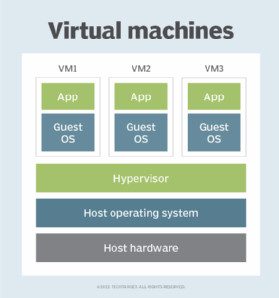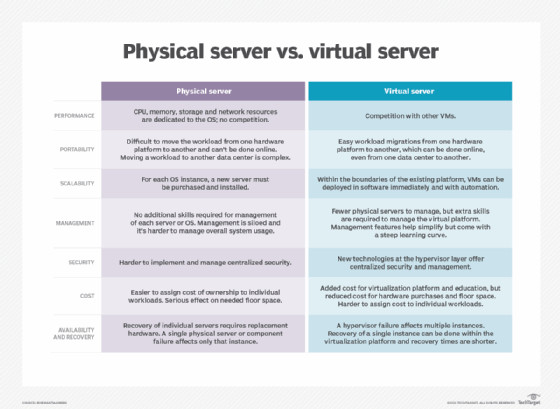In today’s digital landscape, the term “server” is thrown around frequently, but what exactly is a virtual server? Often referred to as a Virtual Machine (VM), a virtual server is essentially a software-defined server that resides within a physical server. It acts as an independent computing environment, mirroring the functionalities of a dedicated physical server, but with a crucial difference: it shares hardware resources with other virtual servers. This abstraction makes virtual servers a cornerstone of modern cloud computing and data centers, offering flexibility and efficiency that traditional physical servers simply can’t match.
Diving Deeper: How Virtual Servers Work
The magic behind virtual servers lies in a technology called virtualization. At its heart is a sophisticated piece of software known as a hypervisor. Imagine the hypervisor as a traffic controller for a physical server. It sits directly on the server’s hardware and divides it into multiple isolated virtual environments – these are your virtual servers. Each VM operates with its own operating system (OS), applications, and resources, completely separated from other VMs on the same physical server.
This isolation is key. The hypervisor creates an abstraction layer, allowing each VM to believe it has dedicated access to the underlying hardware, even though it’s sharing resources like CPU, RAM, storage, and network bandwidth with others. This efficient sharing is what makes virtual servers so powerful and cost-effective.
Types of Virtualization
There are several methods of virtualization, each with its own approach to managing resources and interaction between the virtual server and the physical hardware:
-
Full Virtualization: In full virtualization, the hypervisor takes complete control of the interaction between the virtual server and the physical hardware, especially the CPU. The VM is completely unaware that it’s in a virtualized environment. The hypervisor emulates the entire hardware stack, providing a complete virtual hardware environment for each VM. This method ensures high compatibility and isolation, as each VM operates independently without needing modifications to its OS.
 how does virtualization work
how does virtualization work -
Paravirtualization: Paravirtualization takes a different approach. Instead of the hypervisor emulating hardware, the operating system running within the VM is modified to be aware of the virtualization and to cooperate with the hypervisor. This allows for more efficient communication between the VM and the hypervisor, potentially leading to improved performance compared to full virtualization. However, it requires OS modifications, limiting the choice of operating systems that can be used.
-
OS-Level Virtualization: Also known as containerization, OS-level virtualization operates at a higher level. Instead of virtualizing the hardware, it virtualizes the operating system itself. Multiple isolated user-space instances (containers) run on a single OS kernel. This method is very resource-efficient and lightweight, as it avoids the overhead of running a full guest OS for each instance. However, it typically requires all virtual servers on the host to use the same operating system kernel, usually Linux.
Consider a business requiring different server functionalities, such as a web server to host their website, a database server to manage customer data, and a mail server for email communications. Traditionally, this would necessitate deploying and managing multiple physical servers. With server virtualization, the business can consolidate all these services onto a single physical server by creating separate virtual servers for each function. This significantly reduces hardware costs, space requirements, and management overhead.
The Compelling Benefits of Using a Virtual Server
Virtual servers have become increasingly popular due to the numerous advantages they offer to organizations of all sizes:
Cost Efficiency
Virtual servers are significantly more cost-effective than physical servers. Because multiple VMs share the resources of a single physical server, the hardware costs are distributed across multiple users or departments. This shared infrastructure model reduces the need for organizations to invest in and maintain numerous physical servers, leading to substantial savings on hardware procurement, maintenance, and energy consumption. Furthermore, virtual servers often come with flexible pricing models, allowing businesses to pay for only the resources they consume, further optimizing costs.
Enhanced Resource Utilization
Server virtualization dramatically improves resource utilization. Physical servers often sit idle or underutilized, wasting valuable computing resources. Virtual servers, on the other hand, ensure that the underlying hardware is used much more efficiently. The hypervisor dynamically allocates resources to VMs based on their needs, maximizing the utilization of CPU, memory, and storage. This prevents resource wastage and allows organizations to get the most out of their hardware investments.
Eco-Friendly IT
Choosing virtual servers is a step towards green technology. By consolidating multiple workloads onto fewer physical servers, virtualization significantly reduces energy consumption and the physical footprint of IT infrastructure. Less hardware means less power consumption for operation and cooling, contributing to a more sustainable and environmentally responsible IT strategy. This aligns with the growing global emphasis on reducing carbon emissions and promoting energy efficiency.
Rapid Deployment
Instant provisioning is a key advantage of virtual servers. Unlike physical servers, which can take hours or even days to procure, set up, and configure, virtual servers can be deployed in minutes. With a few clicks, new VMs can be created and configured, enabling businesses to quickly respond to changing demands and deploy new applications or services rapidly. This agility is crucial in fast-paced business environments. Moreover, cloning existing VM templates further accelerates deployment and ensures consistency across server environments.
Streamlined DevOps
Virtual servers are ideal for efficient DevOps practices. Maintenance, patching, and updates can be performed on virtual servers with minimal disruption to production environments. In many cases, live migration allows VMs to be moved between physical servers without downtime. Furthermore, virtual environments are perfect for development and testing. Developers can easily create isolated VMs to test new software or configurations without affecting other environments, accelerating development cycles and improving software quality.
Boosted Productivity
The speed and ease of deploying and managing virtual servers translate directly into improved IT productivity. IT teams spend less time on hardware setup and maintenance and more time on strategic initiatives and innovation. The ability to quickly provision and decommission servers as needed streamlines IT operations and allows organizations to be more agile and responsive to business needs.
Simplified Disaster Recovery
Virtualization significantly simplifies disaster recovery (DR). Virtual servers are inherently more portable than physical servers. VMs can be easily backed up, replicated, and restored, making it much easier to recover from hardware failures or disasters. DR plans can be implemented more effectively and cost-efficiently using virtual servers, as the need for identical physical hardware at a DR site is eliminated. VM replication and automated failover capabilities ensure business continuity in the event of an outage.
Potential Drawbacks of Virtual Servers
While virtual servers offer a wealth of benefits, it’s also important to acknowledge potential drawbacks. One common concern is the “noisy neighbor” effect, where the performance of one VM can be affected by the resource consumption of another VM on the same physical server. Resource contention can occur if VMs are not properly managed and allocated resources are not balanced. Another consideration is security. While hypervisors provide isolation, misconfigurations or vulnerabilities in the hypervisor itself could potentially impact multiple VMs. Proper security practices and robust hypervisor management are crucial to mitigate these risks.
Virtual Server vs. Physical Server: A Detailed Comparison
Understanding the key differences between virtual and physical servers is crucial for making informed decisions about IT infrastructure:
- Cost: Physical servers have a higher upfront cost due to hardware expenses and ongoing maintenance. Virtual servers, leveraging shared hardware, offer lower initial costs and more predictable operational expenses.
- Performance: Physical servers, with dedicated resources, can deliver superior performance for resource-intensive workloads. Virtual servers, sharing resources, might experience performance variability depending on workload demands and resource allocation.
- Space: Virtual servers are significantly more space-efficient, allowing multiple VMs to reside on a single physical server, reducing data center footprint. Physical servers require dedicated physical space for each server unit.
- Implementation: Physical server implementation is a more complex and time-consuming process involving manual hardware setup. Virtual servers can be deployed rapidly through software, simplifying and accelerating implementation.
- Security: Physical servers offer isolated security environments. Virtual servers, while isolated by the hypervisor, require careful security management of the shared infrastructure to prevent cross-VM vulnerabilities.
- Scalability: Virtual servers are highly scalable, allowing for on-demand resource adjustments and easy scaling up or down as needed. Physical servers require hardware upgrades for scaling, which can be time-consuming and disruptive.
- Availability and Recovery: Physical servers are susceptible to downtime due to hardware failures. Virtual servers offer better availability through features like live migration and easier disaster recovery options due to VM portability.
- Management: Physical server management can be complex and siloed, requiring more manual intervention. Virtual servers offer centralized management through hypervisor tools, simplifying administration but requiring specialized virtualization expertise.
 physical vs. virtual servers
physical vs. virtual servers
Beyond Servers: Understanding Virtual Desktops (VDI)
While we’ve focused on virtual servers, it’s worth briefly mentioning virtual desktops, which are often related. A virtual desktop, accessed through Virtual Desktop Infrastructure (VDI), is essentially a virtualized operating system environment presented to end-users. Instead of running an OS and applications on their local device, users access a desktop environment hosted on a server in a data center. VDI leverages virtualization technology, often running virtual desktops on VMs, but it serves a different purpose – providing users with remote access to centralized desktop environments, enhancing security, manageability, and flexibility for end-user computing.
In conclusion, virtual servers have revolutionized IT infrastructure by offering a flexible, scalable, and cost-effective alternative to traditional physical servers. Their ability to optimize resource utilization, simplify management, and enhance business agility makes them a critical component of modern IT environments and cloud computing. Understanding “What Is A Virtual Server” and its benefits is essential for any organization looking to leverage the power of virtualization to drive efficiency and innovation.


